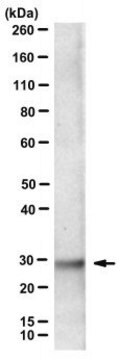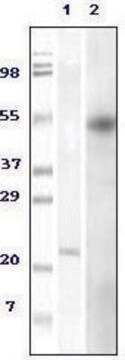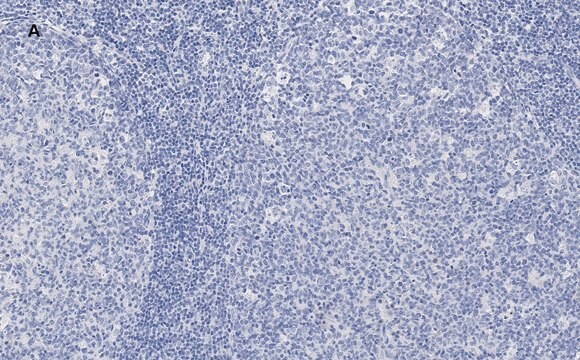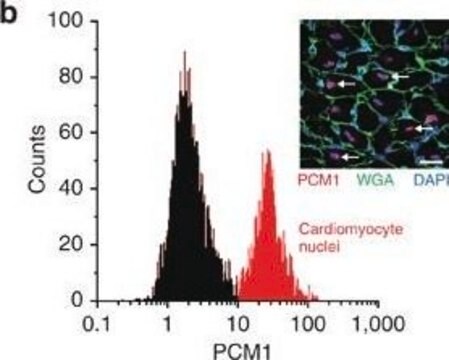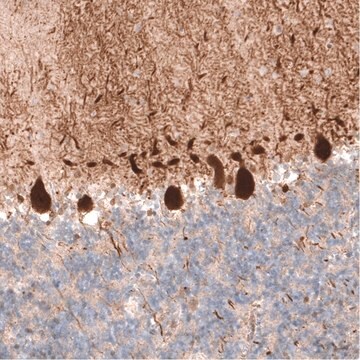MAB1273
Anti-Mitochondria Antibody, surface of intact mitochondria, clone 113-1
clone 113-1, Chemicon®, from mouse
About This Item
Recommended Products
biological source
mouse
Quality Level
antibody form
purified immunoglobulin
antibody product type
primary antibodies
clone
113-1, monoclonal
species reactivity
human
should not react with
mouse, rat
manufacturer/tradename
Chemicon®
technique(s)
immunofluorescence: suitable
immunohistochemistry (formalin-fixed, paraffin-embedded sections): suitable
immunoprecipitation (IP): suitable
input
sample type neural stem cell(s)
isotype
IgG1
shipped in
dry ice
target post-translational modification
unmodified
General description
Specificity
MAB1273 recognizes a 65 kD protein by immunoprecipitation. Antibody produces the stringy, "spaghetti-like" staining patten in the cytoplasm of human cells.
Immunogen
Application
1:100 dilutoin from a previous lot was used. Works best with organic fixatives (acetone, methanol, etc). 2% PFA for 10-15 min can be used but stronger use of formalin or 4% PFA limits staining.
The antibody has been used to isolate intact mitochondria from freeze/thaw lysates of living cells via conjugation to magnetic beads {http://www.dynalbiotech.com}.
Immunohistochemistry in paraffin embedded tissues:
Requires citric acid/microwave antigen retrieval; enhanced ABC or amplified detection systems recommended.
Optimal Staining With EDTA Buffer, pH 8.0, Epitope Retrieval: Heart Ventricle Epithelium
The antibody has been used to isolate intact mitochondria from freeze/thaw lysates of living cells via conjugation to magnetic beads {http://www.dynalbiotech.com}.
Indirect immunofluorescence:
1:10-1:50 dilution from a previous lot was used, 30 - 100 μL per slide well.
MAB1273 recognizes a 65 kD protein by immunoprecipitation.
Optimal working dilutions and protocols must be determined by the end user.
Quality
Immunohistochemistry(paraffin) Analysis:
Mitochondria (cat. # MAB1273) staining on heart ventricle cells. Tissue pretreated with EDTA, pH 8.0This lot of antibody was diluted to 1:80, using IHC-Select Detection with HRP-DAB. Immunoreactivity is seeing the circular-granular layer surrounding the nucleus of the cells.
Optimal Staining With EDTA Buffer, pH 8.0, Epitope Retrieval: Heart Ventricle Epithelium
Target description
Physical form
Storage and Stability
Analysis Note
COS7 cells.
Other Notes
Legal Information
Not finding the right product?
Try our Product Selector Tool.
Storage Class Code
12 - Non Combustible Liquids
WGK
WGK 2
Flash Point(F)
Not applicable
Flash Point(C)
Not applicable
Certificates of Analysis (COA)
Search for Certificates of Analysis (COA) by entering the products Lot/Batch Number. Lot and Batch Numbers can be found on a product’s label following the words ‘Lot’ or ‘Batch’.
Already Own This Product?
Find documentation for the products that you have recently purchased in the Document Library.
Our team of scientists has experience in all areas of research including Life Science, Material Science, Chemical Synthesis, Chromatography, Analytical and many others.
Contact Technical Service
